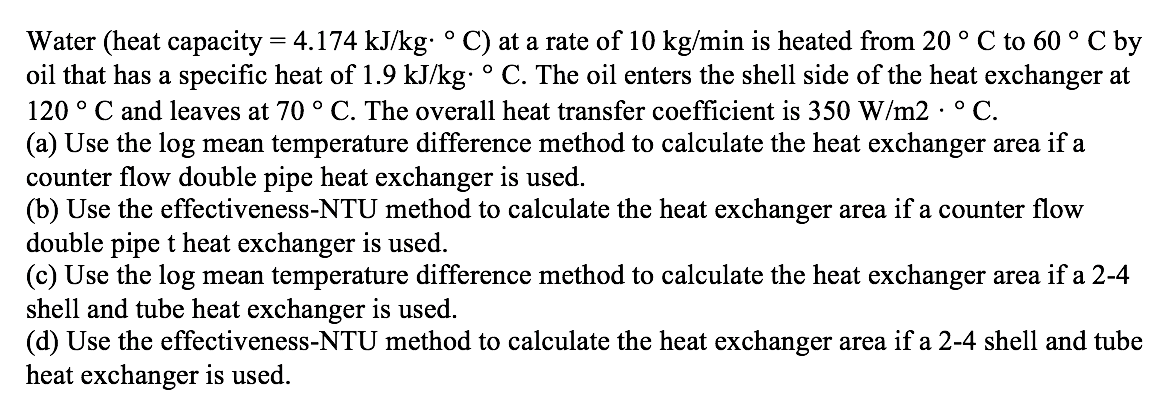Water (heat capacity = 4.174 kJ/kg: ° C) at a rate of 10 kg/min is heated from 20 ° C to 60 oil that has a specific heat of 1.9 kJ/kg: ° C. The oil enters the shell side of the heat exchanger at 120 ° C and leaves at 70 ° C. The overall heat transfer coefficient is 350 W/m2 · ° C. (a) Use the log mean temperature difference method to calculate the heat exchanger area if a counter flow double pipe heat exchanger is used. (b) Use the effectiveness-NTU method to calculate the heat exchanger area if a counter flow double pipe t heat exchanger is used. (c) Use the log mean temperature difference method to calculate the heat exchanger area if a 2-4 shell and tube heat exchanger is used. by
Water (heat capacity = 4.174 kJ/kg: ° C) at a rate of 10 kg/min is heated from 20 ° C to 60 oil that has a specific heat of 1.9 kJ/kg: ° C. The oil enters the shell side of the heat exchanger at 120 ° C and leaves at 70 ° C. The overall heat transfer coefficient is 350 W/m2 · ° C. (a) Use the log mean temperature difference method to calculate the heat exchanger area if a counter flow double pipe heat exchanger is used. (b) Use the effectiveness-NTU method to calculate the heat exchanger area if a counter flow double pipe t heat exchanger is used. (c) Use the log mean temperature difference method to calculate the heat exchanger area if a 2-4 shell and tube heat exchanger is used. by
Principles of Heat Transfer (Activate Learning with these NEW titles from Engineering!)
8th Edition
ISBN:9781305387102
Author:Kreith, Frank; Manglik, Raj M.
Publisher:Kreith, Frank; Manglik, Raj M.
Chapter10: Heat Exchangers
Section: Chapter Questions
Problem 10.32P
Related questions
Concept explainers
Heat Exchangers
Heat exchangers are the types of equipment that are primarily employed to transfer the thermal energy from one fluid to another, provided that one of the fluids should be at a higher thermal energy content than the other fluid.
Heat Exchanger
The heat exchanger is a combination of two words ''Heat'' and ''Exchanger''. It is a mechanical device that is used to exchange heat energy between two fluids.
Question
100%

Transcribed Image Text:C by
Water (heat capacity = 4.174 kJ/kg: ° C) at a rate of 10 kg/min is heated from 20 ° C to 60 °
oil that has a specific heat of 1.9 kJ/kg: ° C. The oil enters the shell side of the heat exchanger at
120 ° C and leaves at 70 ° C. The overall heat transfer coefficient is 350 W/m2 · ° C.
(a) Use the log mean temperature difference method to calculate the heat exchanger area if a
counter flow double pipe heat exchanger is used.
(b) Use the effectiveness-NTU method to calculate the heat exchanger area if a counter flow
double pipe t heat exchanger is used.
(c) Use the log mean temperature difference method to calculate the heat exchanger area if a 2-4
shell and tube heat exchanger is used.
(d) Use the effectiveness-NTU method to calculate the heat exchanger area if a 2-4 shell and tube
heat exchanger is used.
Expert Solution
This question has been solved!
Explore an expertly crafted, step-by-step solution for a thorough understanding of key concepts.
Step by step
Solved in 4 steps

Knowledge Booster
Learn more about
Need a deep-dive on the concept behind this application? Look no further. Learn more about this topic, mechanical-engineering and related others by exploring similar questions and additional content below.Recommended textbooks for you

Principles of Heat Transfer (Activate Learning wi…
Mechanical Engineering
ISBN:
9781305387102
Author:
Kreith, Frank; Manglik, Raj M.
Publisher:
Cengage Learning

Principles of Heat Transfer (Activate Learning wi…
Mechanical Engineering
ISBN:
9781305387102
Author:
Kreith, Frank; Manglik, Raj M.
Publisher:
Cengage Learning